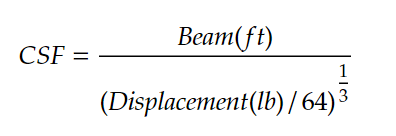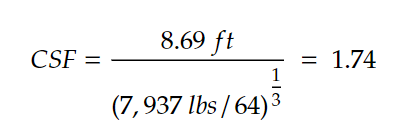If you’re considering buying a boat and are sifting through different listings and offers, you’re likely also weighing various ratios, like the comfort ratio or the sail area displacement ratio. You might have also encountered the capsize ratio for sailboats, sometimes referred to as the capsize screening formula (CSF). In this article, we aim to delve deeper into this particular metric to help you understand what exactly the CSF is, its practical use, and its limitations.
What is the Capsize Ratio or Capsize Screening Formula (CSF)?
The capsize ratio is a measure that indicates a boat’s ability to resist capsizing or to recover if it does capsize. A lower number suggests greater stability, with a ratio below 2.0 generally considered satisfactory.
The CSF calculation focuses solely on comparing a boat’s beam (width) with its displacement since a broader beam increases the chances of capsizing, whereas a heavier displacement diminishes this risk.
This formula was developed in response to the tragic events of the 1979 Fastnet Race, a disaster in which only 86 out of 303 starting boats finished the race, and 19 sailors lost their lives. In the aftermath, the Cruising Club of America set out to analyze data from race boats, leading to the creation of this formula as a means to assess the seaworthiness of vessels participating in such events.
How do you calculate the Capsize Ratio?
The capsize screening formula stands out for its simplicity, involving just two factors, making its calculation pretty easy. It’s calculated by dividing a vessel’s maximum beam by the cube root of its displacement, measured in cubic feet. To convert displacement from pounds to cubic feet, you divide the displacement in pounds by 64. Here’s the formula:

- Displacement: The weight of the boat in pounds.
- Beam: The width of the boat at its widest point.
When you are comparing different boats and don’t want to to calculate each ratio on your own, it is typically found in the sales catalogue. The simplest approach is to look up the specific vessel on sailboatdata.com, where you can find all the standard ratios already calculated.
So how is the CSF calculated for our own boat, a Fellowship 28?
The relevant specifications:
- Beam: 8.69 ft
- Displacement: 7,937 lbs (according to the technical specifications)

So this means the Fellowship 28 has a Capsize Ratio of 1.74. When comparing it to very similar boats, this gives an indication whether it is more or less likely to resist capsizing.
Limitations and problems with the CSF
The Capsize Ratio is somewhat controversial and has sparked many discussions. The primary concern is its simplicity, as it only holds significant meaning when comparing extremely similar boat types and lengths. Since the ratio does not account for hull shape, ballast location, or any other metrics, it is often argued to be an inadequate measure.
An example cited in a thread on cruisersforum illustrates this point: a boat with a deep ballast keel weighing 10,000 pounds and a beam width of 10 ft is deemed to have the same capsizing resistance as a boat with 10,000 pounds in the mast and the same beam width, according to the formula. While this may be an exaggerated example, it clearly demonstrates the formula’s limitations. I recommend reading the linked thread for a more detailed discussion on the topic, where even John Rousmaniere, a well-known and reputable author who participated in the Fastnet race and wrote the book “Fastnet, Force 10: The Deadliest Storm in the History of Modern Sailing,” contributes to the discussion.

